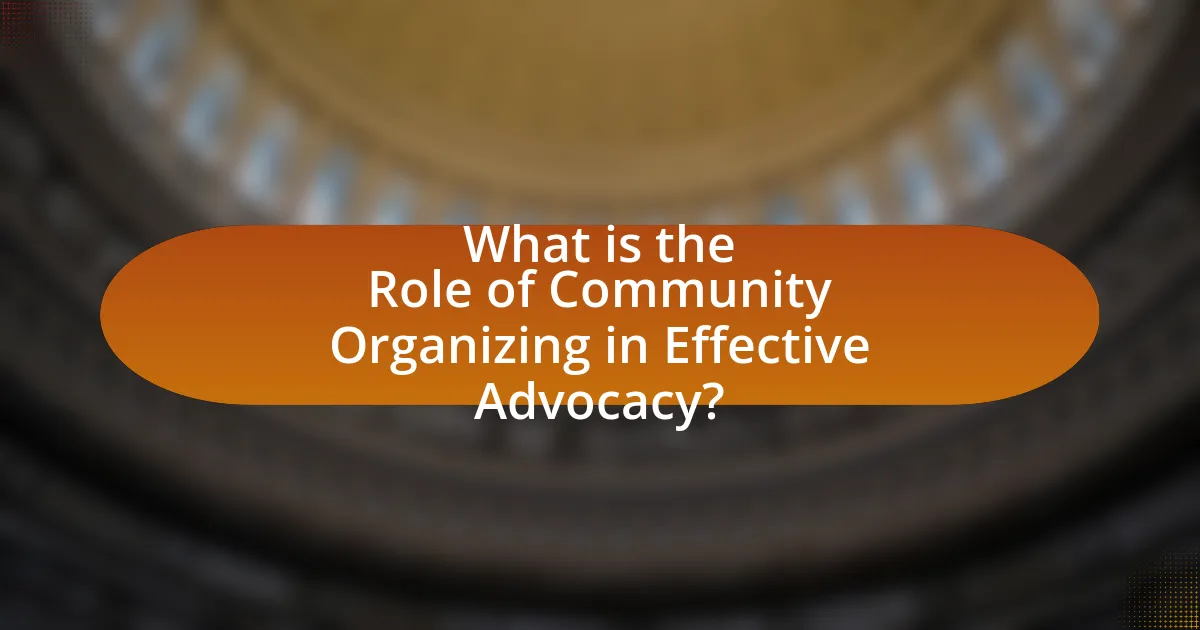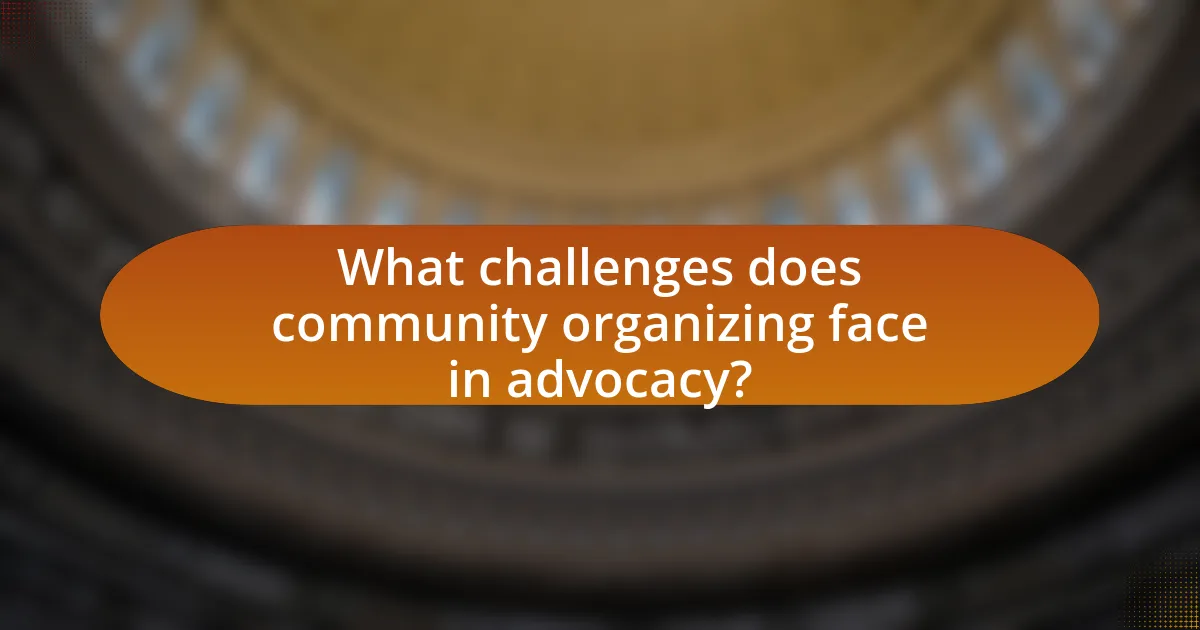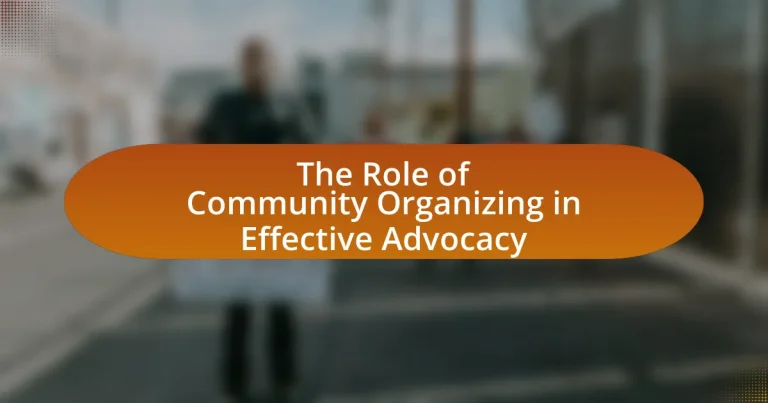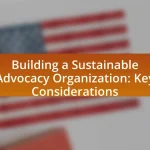Community organizing is a vital component of effective advocacy, as it mobilizes individuals to collectively address shared issues and influence decision-makers. The article explores how community organizing empowers marginalized groups, enhances collective action, and contributes to successful policy changes through grassroots movements. Key principles such as empowerment, participation, and collaboration are highlighted, along with strategies for building coalitions and overcoming challenges like resource limitations and resistance from authorities. Additionally, the role of leadership and technology in modern community organizing is examined, emphasizing best practices for evaluating advocacy efforts and adapting to changing social dynamics.

What is the Role of Community Organizing in Effective Advocacy?
Community organizing plays a crucial role in effective advocacy by mobilizing individuals to collectively address shared issues and influence decision-makers. This process fosters a sense of empowerment among community members, enabling them to articulate their needs and advocate for change. Research indicates that organized communities are more successful in achieving policy changes; for instance, the National Community Organizing Network reports that grassroots movements have led to significant legislative reforms in areas such as healthcare and education. By building relationships and networks, community organizing enhances the capacity of individuals to engage in advocacy, ultimately leading to more impactful outcomes.
How does community organizing contribute to advocacy efforts?
Community organizing significantly enhances advocacy efforts by mobilizing individuals around shared interests and goals. This collective action fosters a sense of empowerment among community members, enabling them to effectively voice their concerns and influence decision-makers. For instance, the 2011 Occupy Wall Street movement exemplified how grassroots organizing can bring attention to economic inequality, leading to broader discussions on wealth distribution and corporate influence in politics. By creating networks of support and facilitating communication, community organizing amplifies the impact of advocacy initiatives, making them more visible and compelling to policymakers and the public.
What are the key principles of community organizing?
The key principles of community organizing include empowerment, participation, and collaboration. Empowerment focuses on enabling individuals and groups to gain control over their lives and influence decisions that affect them. Participation emphasizes the active involvement of community members in the organizing process, ensuring that their voices are heard and valued. Collaboration involves building partnerships among various stakeholders, fostering a sense of shared responsibility and collective action. These principles are supported by the work of community organizing theorists like Saul Alinsky, who highlighted the importance of grassroots involvement in effecting social change.
How does community organizing empower marginalized groups?
Community organizing empowers marginalized groups by providing them with a collective voice and the tools necessary to advocate for their rights and needs. This process fosters solidarity among individuals who share similar challenges, enabling them to mobilize resources, share information, and strategize effectively. For instance, studies have shown that organized groups can influence policy changes, as seen in the successful campaigns for civil rights and social justice, where collective action led to significant legislative reforms. By facilitating leadership development and enhancing political engagement, community organizing equips marginalized individuals with the skills and confidence to challenge systemic inequalities, thereby promoting social change.
Why is community organizing essential for effective advocacy?
Community organizing is essential for effective advocacy because it mobilizes individuals to collectively address shared issues, amplifying their voices and increasing their influence. By fostering a sense of solidarity and shared purpose, community organizing enables diverse groups to identify common goals, strategize effectively, and advocate for policy changes that reflect their collective interests. Research shows that organized communities are more successful in achieving policy outcomes; for instance, a study by the National Community Organizer Network found that organized groups were 50% more likely to secure favorable policy changes compared to unorganized efforts. This demonstrates that community organizing not only enhances participation but also significantly boosts the effectiveness of advocacy initiatives.
What impact does community organizing have on policy change?
Community organizing significantly influences policy change by mobilizing individuals to advocate for collective interests, thereby amplifying their voices in the political arena. This grassroots approach fosters civic engagement, enabling communities to identify issues, develop solutions, and pressure policymakers to enact reforms. For instance, the successful campaign for the Affordable Care Act in the United States was largely driven by community organizing efforts that united diverse groups to advocate for healthcare access, demonstrating how organized communities can effectively shape legislative outcomes.
How does community organizing enhance collective action?
Community organizing enhances collective action by mobilizing individuals around shared interests and goals, fostering a sense of solidarity and empowerment. This process involves identifying common issues, building relationships among community members, and developing strategies to address these challenges collectively. Research indicates that organized communities are more effective in advocating for policy changes, as evidenced by the success of grassroots movements in achieving legislative reforms, such as the Civil Rights Movement, which demonstrated how collective action can lead to significant societal change.

What strategies are used in community organizing for advocacy?
Community organizing for advocacy employs strategies such as building relationships, mobilizing community members, and leveraging collective power. Building relationships involves connecting with individuals and groups to foster trust and collaboration, which is essential for effective advocacy. Mobilizing community members includes organizing events, campaigns, and actions that engage people in the advocacy process, ensuring their voices are heard. Leveraging collective power means uniting individuals around common goals to amplify their impact, often leading to successful policy changes or social justice outcomes. These strategies are supported by historical examples, such as the Civil Rights Movement, where grassroots organizing led to significant legislative changes.
How do grassroots movements utilize community organizing?
Grassroots movements utilize community organizing to mobilize individuals around shared interests and goals, fostering collective action. By engaging community members through meetings, workshops, and outreach, these movements build networks that empower participants to advocate for social change. For instance, the Civil Rights Movement in the 1960s effectively used community organizing to unite diverse groups, leading to significant legislative changes such as the Civil Rights Act of 1964. This historical example illustrates how grassroots movements leverage community organizing to create a structured approach for addressing local issues and influencing broader policy outcomes.
What are the stages of building a grassroots movement?
The stages of building a grassroots movement include awareness, mobilization, organization, action, and sustainability. Initially, awareness involves educating the community about an issue, which is crucial for generating interest and support. Mobilization follows, where individuals are encouraged to participate and engage with the cause, often through outreach efforts. Next, organization focuses on structuring the movement, establishing leadership roles, and creating a strategic plan. Action entails implementing campaigns or initiatives to address the identified issues, often through protests, petitions, or community events. Finally, sustainability ensures the movement’s longevity by fostering ongoing engagement, securing resources, and adapting to changing circumstances. Each stage is essential for the effective development and impact of a grassroots movement.
How do grassroots movements engage community members?
Grassroots movements engage community members by fostering direct participation and creating a sense of ownership among individuals. These movements utilize strategies such as organizing local events, conducting outreach campaigns, and facilitating discussions that empower community members to voice their concerns and contribute to decision-making processes. For instance, research by the Stanford Social Innovation Review highlights that grassroots organizations often employ door-to-door canvassing and community meetings to build relationships and mobilize support, effectively increasing civic engagement and collective action.
What role does leadership play in community organizing?
Leadership is crucial in community organizing as it provides direction, motivation, and a framework for collective action. Effective leaders identify community needs, mobilize resources, and foster collaboration among diverse groups, ensuring that voices are heard and represented. Research shows that strong leadership enhances community engagement and increases the likelihood of achieving advocacy goals, as seen in successful movements like the Civil Rights Movement, where leaders like Martin Luther King Jr. galvanized support and coordinated efforts for systemic change.
How can effective leaders inspire community involvement?
Effective leaders inspire community involvement by fostering a shared vision and creating opportunities for participation. They engage community members through transparent communication, demonstrating the importance of collective action for achieving common goals. Research shows that leaders who actively involve citizens in decision-making processes increase civic engagement; for instance, a study by the National Civic League found that communities with participatory leadership models saw a 30% increase in volunteerism. By empowering individuals and recognizing their contributions, effective leaders cultivate a sense of ownership and responsibility, which further motivates community involvement.
What skills are essential for leaders in community organizing?
Essential skills for leaders in community organizing include effective communication, relationship-building, strategic planning, and problem-solving. Effective communication allows leaders to articulate goals and mobilize community members, while relationship-building fosters trust and collaboration among diverse groups. Strategic planning enables leaders to set clear objectives and develop actionable plans, and problem-solving skills help navigate challenges and adapt to changing circumstances. These skills are critical for successful advocacy, as they empower leaders to engage communities, influence policy, and drive social change.

What challenges does community organizing face in advocacy?
Community organizing faces several challenges in advocacy, including resource limitations, lack of public awareness, and internal conflicts. Resource limitations often hinder the ability to mobilize effectively, as many community organizations operate on tight budgets and rely on volunteer efforts. Lack of public awareness can result in insufficient community engagement, making it difficult to garner support for advocacy initiatives. Internal conflicts, such as differing priorities among community members, can lead to fragmentation and weaken collective action. These challenges are documented in studies, such as “The Challenges of Community Organizing” by the National Community Organizing Network, which highlights the impact of these factors on advocacy outcomes.
What obstacles do community organizers encounter?
Community organizers encounter several obstacles, including limited funding, resistance from local authorities, and challenges in mobilizing community members. Limited funding restricts their ability to implement programs and outreach efforts effectively, as many rely on grants or donations that may not be consistent. Resistance from local authorities can manifest as bureaucratic hurdles or outright opposition to initiatives, making it difficult to gain necessary permits or support. Additionally, mobilizing community members can be challenging due to apathy, lack of awareness, or differing priorities within the community, which can hinder collective action and engagement. These obstacles significantly impact the effectiveness of community organizing efforts in advocacy.
How can community organizers overcome resistance from authorities?
Community organizers can overcome resistance from authorities by building coalitions and fostering relationships based on trust and mutual respect. Establishing alliances with other organizations and stakeholders amplifies their voice and demonstrates a united front, which can pressure authorities to engage constructively. For instance, successful campaigns, such as the Fight for $15 movement, utilized broad coalitions to advocate for minimum wage increases, showcasing how collective action can influence policy changes despite initial resistance from government entities. Additionally, employing data-driven arguments and presenting compelling narratives can help community organizers effectively communicate their needs and concerns, making it harder for authorities to dismiss their demands.
What strategies can be employed to address funding limitations?
To address funding limitations, organizations can employ strategies such as diversifying funding sources, enhancing grant writing skills, and building partnerships with local businesses. Diversifying funding sources reduces reliance on a single income stream, which can stabilize finances; for instance, organizations can seek donations, grants, and crowdfunding. Enhancing grant writing skills increases the likelihood of securing funding, as effective proposals can significantly improve success rates; research indicates that well-crafted proposals can lead to funding increases of up to 50%. Building partnerships with local businesses can provide mutual benefits, such as sponsorships or in-kind contributions, which can alleviate financial pressures while fostering community support.
How can community organizing adapt to changing social dynamics?
Community organizing can adapt to changing social dynamics by employing flexible strategies that respond to the evolving needs and concerns of diverse populations. This adaptability includes utilizing technology for communication and outreach, fostering inclusive leadership that reflects community demographics, and engaging in continuous dialogue to understand shifting priorities. For instance, during the COVID-19 pandemic, many organizations shifted to virtual platforms to maintain engagement, demonstrating the importance of adaptability in response to immediate social changes. Additionally, research by the National Community Organizing Network highlights that successful community organizing often involves assessing local issues through surveys and community forums, ensuring that the organizing efforts remain relevant and effective in addressing the current social landscape.
What role does technology play in modern community organizing?
Technology plays a crucial role in modern community organizing by enhancing communication, mobilization, and resource sharing among community members. Digital platforms, such as social media and messaging apps, facilitate real-time information dissemination, allowing organizers to quickly rally support for causes and events. For instance, a study by the Pew Research Center found that 69% of adults in the U.S. use social media, which can amplify outreach efforts and engage a broader audience. Additionally, technology enables the use of data analytics to identify community needs and measure the impact of organizing efforts, thereby improving strategic planning and effectiveness.
How can community organizers respond to shifts in public opinion?
Community organizers can respond to shifts in public opinion by adapting their strategies to align with the evolving sentiments of the community. This involves actively monitoring public discourse through surveys, social media analysis, and community meetings to gauge changes in attitudes. For instance, when public support for environmental policies increased in the 2010s, organizers shifted their messaging to emphasize sustainability and community benefits, which helped mobilize greater participation. By utilizing data-driven approaches and engaging in open dialogue, community organizers can effectively pivot their campaigns to resonate with current public concerns, thereby enhancing their advocacy efforts.
What are best practices for successful community organizing in advocacy?
Successful community organizing in advocacy involves building strong relationships, mobilizing diverse stakeholders, and creating a clear, actionable plan. Effective organizers prioritize relationship-building by engaging community members through regular communication and inclusive meetings, fostering trust and collaboration. Mobilizing diverse stakeholders ensures a broad representation of voices, which enhances the legitimacy and impact of advocacy efforts. Additionally, a clear, actionable plan outlines specific goals, strategies, and timelines, allowing the community to focus its efforts and measure progress. Research shows that organizations employing these practices are more likely to achieve their advocacy objectives, as evidenced by successful campaigns that have led to policy changes and increased community engagement.
How can community organizers build effective coalitions?
Community organizers can build effective coalitions by fostering relationships based on trust, shared goals, and mutual respect among diverse stakeholders. This involves identifying common interests and aligning objectives to create a unified vision. Research indicates that successful coalitions often engage in regular communication, collaborative decision-making, and inclusive practices, which enhance participation and commitment. For instance, the National Network for Collaboration emphasizes the importance of establishing clear roles and responsibilities, which can lead to increased accountability and effectiveness in achieving collective goals.
What methods can be used to evaluate the success of advocacy efforts?
To evaluate the success of advocacy efforts, methods such as outcome measurement, stakeholder feedback, and policy impact analysis can be employed. Outcome measurement involves assessing specific changes resulting from advocacy, such as shifts in public opinion or legislative action. Stakeholder feedback gathers insights from those affected by the advocacy, providing qualitative data on its effectiveness. Policy impact analysis examines the direct effects of advocacy on policy changes, using metrics like the number of policies influenced or implemented as a result of advocacy campaigns. These methods collectively provide a comprehensive understanding of advocacy success by quantifying results and gathering diverse perspectives.


